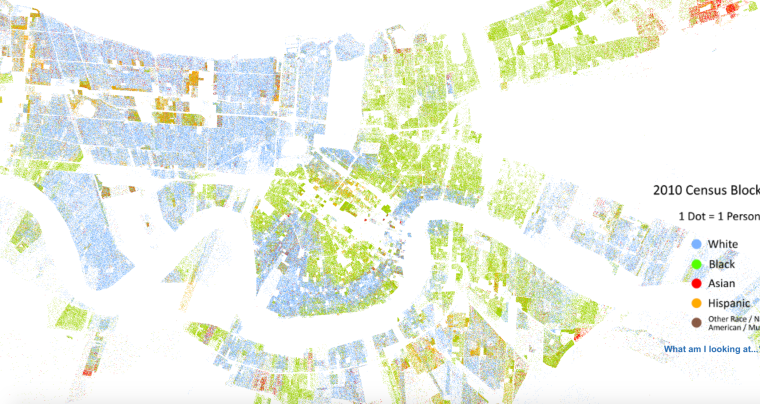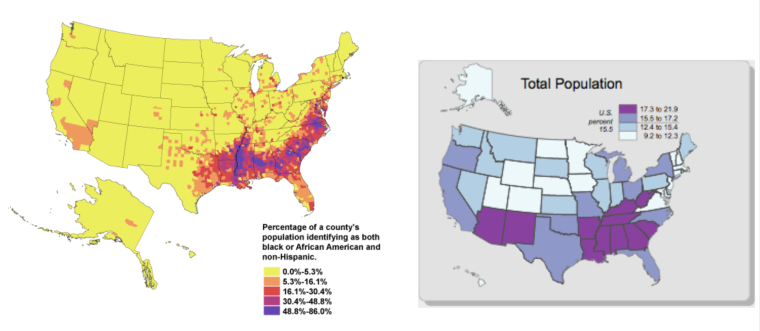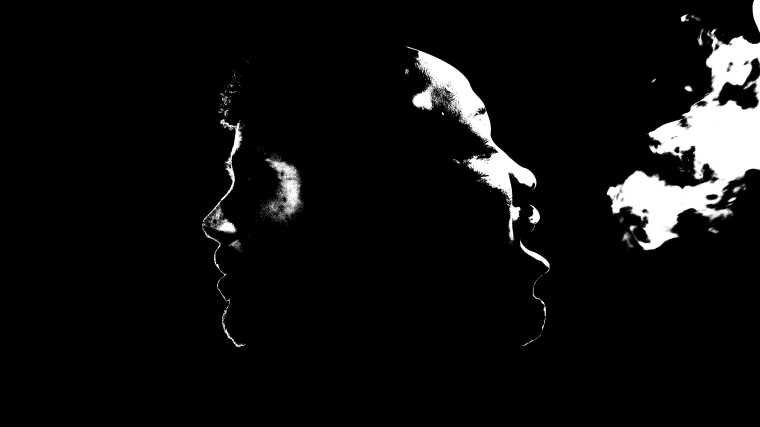<Note: I sincerly apologize for all the spelling and gramatical mistakes, and for nonsense as well. >
What’s up today?
Segregation
New Orleans, who are you? That’s a question « the Data Center » answered in its study « Who Lives in New Orleans and Metro Parishes Now? », from 16 February 2016, analyzing the population of New Orleans and surrounding. For the following, I will focus on New Orleans itself, being conscious that important variation occurred from one parish to another. Another interesting source of information is the Quick Fact Section from census.gov.
Basically, it can be considered that in 2014, Whites represent 33% of the population, blacks 61% and remaining 6% are mainly Hispanics for a total population of 384,320 inhabitants. As a reminder, the national average of the black population is only 13%, almost a five-fold difference. I don’t know if there are any relation between that two facts, but it happens that Louisiana is the third poorest states just after Mississippi and New Mexico (more about it here) with 19,80% of the people living under the poverty threshold.
A striking observation is that population does not mix at all (Fig8). The wonderful racial dot map clearly indicate a strong segregation in the city leading to strong inequalities, or the other way around, who knows.

Poverty
poverty can be divided into several subcategories (Fig9), such has mono-parentals household, incomes, transportation means, education, and so on and so on. let’s have a quick look at it.

 I think that just the scale used is interesting with two distinct comparison point, National average and New Orleans average. Two out of three categories already being over the national average. This really points out an advanced poverty situation, with Claiborne av. almost being a border.
I think that just the scale used is interesting with two distinct comparison point, National average and New Orleans average. Two out of three categories already being over the national average. This really points out an advanced poverty situation, with Claiborne av. almost being a border.
 I know, border is a strong word, but let’s be realistic, just like me, you have seen the racial dot map, green dots (blacks) and blue dots (whites) does not mix so well, while Orange (Hispanics), red (Asians) and green (Blacks) does. Another simple observation is that all the city center and touristic places are critical white. From this map can be recognized the shape of an elephant, the white elephant.
I know, border is a strong word, but let’s be realistic, just like me, you have seen the racial dot map, green dots (blacks) and blue dots (whites) does not mix so well, while Orange (Hispanics), red (Asians) and green (Blacks) does. Another simple observation is that all the city center and touristic places are critical white. From this map can be recognized the shape of an elephant, the white elephant.
<And yeah, the drawing is ugly, on purpose, so skeptics have something obvious to criticized, it indeed look like it has been drawn by a 6 years old or less, and no, I don’t do child exploitation>
If we overlay the racial dot map and the poverty map, it is striking how the white elephant pattern can be found absolutely everywhere. Non-white areas are incredibly much poorer, at every single level, it can be educational, or just in term of employment and incomes. I won’t develop further more, if you want to dig a bit you’ll easily find inequalities, discovering that around 30% of whites man has a bachelor degree when only 12% for blacks have, unbelievable health and hygiene stats, and so on.
Crime
Poverty always evolved side by side with crimes. Sources of information provide different figures, but all agreed on one point, it’s way too damn high! Area vibes says New Orleans crime rate is 76% higher than the national average, and that basically, you have one chance (ha ha, chance) out of twenty to become a victim. Crime wise, the over-year number of victims has increased by 12%, figures confirmed by official nola.gov crime stats, which also denounced an alarming increase in sexual assault and rape. You would be surprised of how many victims you can meet. The saddest point, they learned how to live with it.

The Kaiser Family Foundation/NPR survey of new orleans (Fig10) recently released a statement in which 36% of African american declared being ‘very worried’ to be victim of violent crime against only 17% in whites folks, highlighting once again who are more likely to become a statistic.
In the recent years, New Orleans number of startups has bloomed, much more than the national average, though less than 40% of the business are black owned. Isn’t it strange when you consider that 61% of the population is colored? Meaning that one third of the population own two third of the business. In addition, Statistics does not inform us on the capital represented by those businesses. I could not find any data on on this but I’m ready to bet that the 40% be are talking about represents much less than 40% of the total.
That being said, I could not face or observed direct racism in the city, at my workplace, colored and non-colored people were getting along just fine, but no mixes were observed outside of this context. Each of us had its own place to go, its own crowd. A conclusion is that people of new Orleans can appreciate each other as a human being but segregation and gentrification hit so hard that they just don’t live together.
Tourism, theater and modern slavery
Slowly economics is getting back on the right track. However, the city does not have yet a solid long term plan and the fragilities of the system are deep anchored is the heart of social classes disparities (depicted in James Bobo’s work). Today, most of the state income are brought by tourism, petrol, and a tiny bit of Movie industry.
Now, petrol is owned by huge companies with only a few interests in local issues. As for ”the Hollywood of the south”, even if scenes were shot down south, it is more a ”land for rent” than the industry heartbeat. Most of its attractiveness was due to a ”tax credit program”, a year back, the policy of this program changed a bit, as a consequences the activity immediately slowed down in 2015-2016. It is a proof of instant politics, dynamic, but no lasting spell.
While fossil energy and movie industry can be temporary, tourism is more stable as it is based on history and local culture. In 2014, 9.5 million people came over to visit the city, and they spent 6.8 billion dollars (see official reports). Have a quick thought, the city counts 400 000 inhabitants, over the year, 9.5 million people are coming over, which mean that, in average, at a given point there are twice more tourists than citizens in the city. As travelers only visit 50% of the city (maximum) we can even consider that the ratio is about one to three, maybe one to four in the French quarter. The funny part with it is that locals become minorities…
I worked long enough in the city to notice that most of the visitors were white. Therefore, everything is meant to welcome them and give them the experience they actually want to live. Alligators? right there. Plantation? Let me tell you how was having slaves at this time, and where masters were living… What? Nothing about slavery but just pretty houses? yeah, that’s right, it’s all about identification, no one wants their guests to feel guilty, uncomfortable or something. We don’t want to ruin the party you know, speaking of what, how about listening to some jazz?
If we resume the situation, tourists are whites, owners of almost all the service industries are whites, everyone is white, the city is designed for white entertainment, so where are all the black folks, you know the 61%. Answer: in the kitchens, on the lines, hidden from the scene, always back of the house (black of the house?).
Here is a small story for you. The restaurant I was working in published a job offer for a waiter position. several folks came along, they were given an application form and then sent to the inner patio to fill it. A Handsome, smartly dress and the smart looking black young man walked in, sat in the patio filling his form, another employee start talking to him : ”ho yeah, you come for the dishwasher position right?”… it was inconceivable for that man that a black guy would actually be applying for something else than a back of the house position.
Visitors want to see some real jazz, some real blues, so musicians are taken out of the basement and invited on the scene to sing, play, and dance. And I was wondering what have really evolved since 1860, Black folks do the hard work and entertain white folks, since, they live in the poorest place and no one moves a little finger for them. Visitors are interested in the legacy from the past and only a few thoughts are given to the actual situation. Here come a problem, past IS past. This year, many music legends died, and there is not really anyone to replace them. A lot of effort are invested to camouflage changes and reality, but the string of the puppet show are more and more apparent.
<Before jumping to the next and final point I would like to emphasize one specific aspect, or should I say clarify. I do write a lot about black and white differences in that article, but the true point, is the difference between the one who possesses and the one who does not. Race issues only appear when majority segregate minorities, condemning them to eternal and systematic poverty. It is not about skin colors, it is all about social classes. Same problem occurs everywhere in the world, in different countries with different minorities>
What about the rest of the US:
It’s true, and I’m trying to say it since the beginning, sweet Nola is not like any other place in the US, though, I think it’s only a cultural matter. Let’s start with another Black/White/poverty geography. At the end of secession war, Blacks folks had nowhere to go, they had been brought there, they lived there, they got freed there, they stayed there. All along the Mississippi, and everywhere in the south Black population is above the national average (13%) (Fig11). A look at the US Poverty map inform us that these states represent 60% of the poorest in the US, 20 other percents are Indians reserves states like New Mexico and Arizona (Fig11).

Poorest Cities in the US, with highest crime rates, like Detroit Michigan or Baltimore are also mostly black populated. I feel like there are way too many coincidences here.
I could keep going with examples, and how colored people are more subject to unemployment, how when unemployment goes down, it generally means white unemployment only is dropping , and how this issue can be found in so many places on this planet etc… but I think, that by now, we all got the main point.
There are only a few bad and hateful people on that earth, most of us just don’t know there are such issues, how points of views and experiences can change from on extreme to the other, just because.
I’m not saying we can fix all the problem in the world, get rid of misery, but at least we can try to be fair, sharing struggles and happiness equally between human beings.

Tonino Rizzo-Boyce
New Orleans – Pourquoi cet article
New Orleans – 0. Head and Tail
New Orleans – 1. Unique and beautifull
